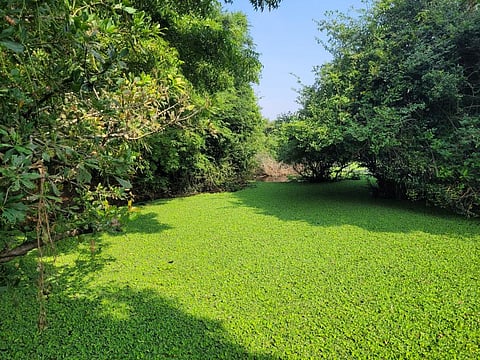Algal blooms of aquatic habitats can be a sign of its health
Conservation and monitoring the health of aquatic ecosystems are major challenges when we consider the increasing population pressure and demand for freshwater. Freshwater habitats are limited and the demand is increasing every day.
Both quantity and quality of water are big concerns, especially for peri-urban and urban wetlands. Under human-mediated disturbances, many urban and peri-urban aquatic bodies are experiencing high nutrient loading from catchments, which ultimately causes eutrophication of waterbodies.
Not just anthropogenic pressure but even local and regional climate-mediated changes affect waterbodies in many ways. High evaporation and less precipitation alter the water level, which ultimately results in cascading effects on the aquatic organisms that are a part of the aquatic system.
The main purpose of assessing aquatic systems is to determine their health status and provide information for protecting and restoring them for healthy and safe human communities. Water quality managers are generally concerned with the growth of algal blooms as a nuisance that affects the taste and odour of water.
Monitoring freshwater habitats for their health using algal communities is one of the most common and economically viable methods. The word ‘algae’ comes from the Latin word alga, which means seaweed.
For the past many decades, freshwater algal assemblages have been used as an ecological indicator, with special reference to organic pollution. They are ecologically sensitive and have specific optimums and tolerances for pH, temperature, nutrients, etc.
Waterbodies adjacent to village Bodaki. Photos: Moumita Karmakar
Waterbodies adjacent to village Beel Akbarpur. Photos: Moumita Karmakar
Algal assemblages are important to sustain other life forms within the freshwater ecosystem, as the primary producers with a high biological activity. Therefore, the study of the algal community provides valuable insight into the overall health of the ecosystem.
Algae are the primary producers of food webs in most aquatic ecosystems and important drivers of biogeochemical cycling. Algal communities represent significant proportions of biodiversity.
Therefore, maintaining optimum levels of algal biodiversity becomes crucial for sustaining ecosystem function, especially under the threat of regional and global changes in environmental conditions and human pressure.
Since algae is now a neglected discipline due to a lack of interest in basic sciences, it motivated me to look around to see what types of algae are growing within the local waterbodies near the campus of Shiv Nadar Institution of Eminence.
There are several natural and man-made wetlands in Beel Akbarpur, Bodaki and Chithera, which make them a unique ecosystem in a peri-urban setting.
Several surveys conducted in different seasons identified three major algal groups: Cyanophyceae (blue-green algae), Chlorophyceae (green algae) and Bacillariophyceae (diatoms). Anabaena, Cylindrospermum and Lyngbya were the dominant blue-green algae (BGA).
Some algae found in the study area
|
Name of the alga |
Role as an ecological indicator |
|
Anabaena species |
Anabaena is common freshwater BGA, found in rice fields, temporary pools, ponds etc. (highest concentration during the summer months). It is commonly found in phosphorus rich water. This BGA can produce neurotoxins like, anatoxin, which is a neuromuscular blocking agent causing respiratory arrest, liver and gastro-intestinal damage and severe dermatitis. Blooms of some Anabaena species may cause death of live stocks and wildlife |
|
Lyngbya species |
It occurs in freshwater, marine water as well as on soil. Lyngbya is known to release some toxins (debromoaplysiatoxin, aplysiatoxin and Lyngbya toxin) into the water. Contact with these toxins can cause irritations, possibly leading to severe dermatitis. |
|
Ankistrodesmus falcatus |
Common in all types of waterbodies but abundant in eutrophic waterbodies. |
|
Closterium species |
Closterium commonly found in acidic water and few species are found in nutrient rich hard water |
|
Stigeoclonium species |
Both epiphytic and periphytic in nature, found in ponds, pools, tanks, reservoirs etc. It also found in sewage channels and heavy metal tolerant. Usually attached on submerged rocks, or aquatic plants. It can clog irrigation canals. |
|
Fragilaria species |
Cosmopolitan, from plankton to benthos. Found in mesotrophic to eutrophic waterbodies. |
Among Chlorophyceae, the dominant genera were Gleocystis, Cosmarium, Scenedesmus, Closterium, Pediastrum, Desmodesmus, Spirogyra, Mougeotia, Stigeoclonium and Oedogonium species.
During December, the waterbodies of Bodaki, Beel Akbarpur and Chithera were dominated by diatoms.
During February, the Chithera waterbody was dominated by Stigeoclonium taxa, whereas the Beel Akbarpur waterbodies were dominated by Anabaena, Lyngbya, Cylindrospermum, Scenedesmus, Oedogonium, Cosmarium species, etc.
In the same period, the nearby agricultural fields were dominated by Spirogyra species. The most common diatoms found were long chains of Fragilaria species. In addition, Pinnularia, Gomphonema, Cymbella and Nitzschia were also very common in all the wetland areas; Discostella and Rhopalodia were also recorded frequently.
The blue-green algae, or cyanobacteria, in waterbodies are known to produce neurotoxins or hepatotoxins. These are potential health hazards, as they can be fatal to humans and animals.
The dominance of algal species such as Oscillatoria, Stigeoclonium, Pinnularia, Nitzschia and Cyclotella indicated sewage contamination. Overall assessment of the algal spectrum in the waterbodies around indicates that few waterbodies have excessive algal growth and are not suitable for domestic use.
A 1969 study by C Mervin Palmer presented a pollution index value of certain algal species.
Scenedesmus has a high pollution index value, according to the study. It was found in almost every waterbody in Beel Akbarpur. Nitzschia, too, has a high pollution index value and was fund in most wetlands.
Almost all the studied waterbodies have taste and odour issues. Community-based conservation and management is recommended for the wetlands, as they are continuously interacting with these systems.
Algal genera as part of pollution index
|
|
Genera index |
Pollution index value |
|
1 |
Scenedesmus |
4 |
|
2 |
Nitzschia |
3 |
|
3 |
Ankistrodesmus |
2 |
|
4 |
Stigeoclonium |
2 |
|
5 |
Gomphonema |
1 |
|
6 |
Closterium |
1 |
|
7 |
Cyclotella |
1 |
Source: C Mervin Palmer / Journal of phycology, 1969


